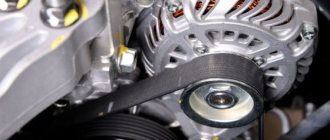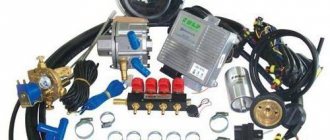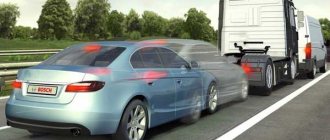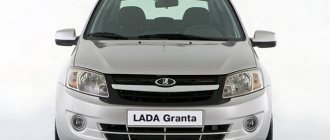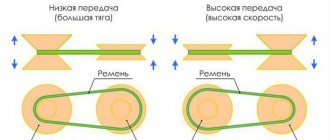New drivers must not only know how to drive a car.
As a rule, novice drivers will continue to constantly encounter various problems that will periodically arise in the process of driving and owning their first car. For most of these drivers, it will take years to gain confidence behind the wheel. Moreover, this directly concerns not only the driving itself, but also relates directly to the car itself.
Unfortunately, in recent years, many novice drivers, owning a car, know virtually nothing about it. As a result, this leads to the fact that many drivers, even experienced ones by today’s standards, practically do not know how to add windshield washer fluid, install a spare tire, etc. in your car.
This is very sad, since we believe that every driver, at least in theory, should understand how the basic systems work in a car. After all, understanding the principles of a car’s operation allows you to understand how a car can behave on the road in a given situation. Naturally, this primarily affects safety. Therefore, we decided to compile a list of principles that should guide every novice driver after receiving their first driver's license.
We would like to say that in addition to knowledge, every new driver who has received a license must constantly improve himself, improving his initial skills not only driving, which he received in a driving school. First of all, a new driver must understand that without sufficient experience you will never become a good driver.
But don’t be upset if you can’t do something while driving for a long time, even after a certain time. Remember that all the necessary driving skills will come to you gradually in the future. For some drivers it’s earlier, and for others a little later. We are all different. But despite this, every driver will sooner or later gain some experience on the road and become much more professional and confident.
Tips for novice drivers
The question of how to choose the right first car is relevant and fair. Many people do not take it seriously enough, believing that any vehicle can be their first car. Some even take the position that you should learn on old Zhiguli cars. These are relics of the past and established stereotypes. If your budget allows you to purchase a modern car with all its advantages, there is no point in spending time and money on gaining experience driving a Kopeyka or similar cars. Once you change to a foreign car, you will feel a huge difference, which will become a problem for a novice motorist.
Before choosing the first passenger car for a beginner, you need to answer a few key questions for yourself. They are related to personal preferences, financial capabilities, operating conditions and other nuances of future vehicle ownership.
When choosing their first cars, motorists should pay attention to the following questions:
- car cost;
- Class;
- drive unit;
- ground clearance;
- engine's type;
- Transmission;
- new or used.
Experts consider these to be important components of a competent approach to buying your first car. By studying the recommendations and taking into account the personal characteristics of the selection, you will be able to make a truly correct purchase.
Car cost
No one will indicate which car a novice driver should choose, since this largely depends on the financial capabilities of each person. Some people can easily afford to spend several million rubles, but for others, a car for 200 thousand rubles seems unaffordable.
Even if your earnings allow it, spending a lot of money on your first car is not recommended. Avoid huge SUVs and long sedans. There is no point in spending money on the richest equipment. This attracts attention from ill-wishers, plus it is difficult for a beginner to understand modern bells and whistles.
The optimal solution to the question of whether a car should be expensive or not is to choose a mid-budget model with simple equipment. Priority is given to clear management and accessible maintenance. As soon as you gain experience, then you will switch to modern cars filled with various electronics.
Without knowing which car is best for an untested novice driver to buy, focus on good handling and visibility from the cockpit. Safety also plays a huge role. Before buying a car on the secondary market or with zero mileage from an official dealer, be sure to look at how many stars the model has received according to the IIHS and NCAP systems. The more airbags a car has, the better.
Selecting a car class
No less often, beginners are interested in what class of vehicle is better to take. If the car is being purchased for a relatively short time to improve skills and gain experience, think about liquidity. After all, in 1-3 years you will have to sell the car.
You will lose the most if you initially buy a luxury car. But the price is slowly falling on popular models, on representatives of the European A and B classes and on cars with entry-level and mid-range equipment. In recent years, compact crossovers have been included in the marketable models.
The class of a vehicle determines its dimensions and maneuverability. For beginners, it is better to buy cars that are easy to drive, capable of clearly responding to steering movements, instantly changing lanes and turning around with minimal effort.
In terms of body type, priority is on the side of hatchbacks and the same compact SUVs. The long trunk of a station wagon or sedan will only interfere with maneuvering, parking and changing lanes. If the car additionally has parking assistance systems, such as parking sensors and a rear view camera, you should not refuse them.
Ground clearance and drive
Next, you should decide which car with which drive and ground clearance is preferable to purchase. Front-wheel drive is unrivaled here. If we take small mid-budget cars as a basis, then there are virtually no rear-wheel drive cars among them. Maybe it's an executive sedan, but it's definitely not one of the best options for a beginner.
In most cases, the choice is not based on off-road requirements. This allows us to exclude different frame SUVs. In principle, a crossover is possible, but here rely on operating conditions and the condition of the roads in your region.
But impressive ground clearance doesn't hurt. For a beginner, this is a mandatory component, since with high ground clearance it is not scary to drive through a poor quality road, park, drive onto the curb, without fear of leaving your front bumper there.
A tall car has its advantages in the form of better control of the road situation. This does not mean that you need to buy only crossovers. Many cars sold in Russia initially have high ground clearance. And some models are specially adapted to the local climate and roads, raising the ground clearance and strengthening the suspension in comparison with versions for other countries.
engine's type
If previously only a gasoline or diesel engine was offered to choose from, now hybrid power plants and fully electric units have been added to their number.
Quite fast warming up in winter speaks in favor of the gasoline internal combustion engine, which cannot be said about the diesel versions. Gasoline engines are also quite economical with a small volume. But you shouldn’t choose frankly weak engines, since it is important to be able to quickly accelerate for overtaking and changing lanes.
Hybrid motors and electrical systems have excellent prospects. But so far they are poorly adapted to the Russian market, they are expensive to maintain and there are problems with charging batteries. Therefore, it is better for a beginner to refuse them.
It is up to the buyer to choose between a diesel and gasoline engine. Diesel is more economical, but such internal combustion engines are usually demanding on the quality of diesel fuel. Plus, a car with a diesel engine initially costs more than a similar car with a gasoline engine. If you are not going to regularly use the car and drive several thousand kilometers a month, the cost of a diesel version of the car is unlikely to justify itself. Then it’s better to take a fairly productive gasoline power unit.
Transmission
Everything is quite simple here. You can choose from a manual or automatic transmission, where the latter has an undeniable advantage in terms of convenience and comfort.
Automatic transmissions allow the driver to minimize the attention paid to the gearbox. Thus, he concentrates on control and does not get confused with the pedals. There is a stereotype according to which you only need to learn mechanics. But if the driver does not even intend to buy a car with a manual transmission in the future, then there is no point in gaining experience with a manual transmission and then buying an automatic. Get an automatic transmission right away. They are the future.
Statements that machines break down quickly and cause a lot of problems are also untrue. The service life of modern automatic transmissions is sometimes not inferior to manual transmissions.
New vs used
It is impossible to say unequivocally whether the car should be new or used. Used cars are less regrettable; people buy them because they are not afraid of being hit or scratched. What difference does it make, one more dent, one less.
But driving a new car on a subconscious level forces the driver to be more attentive and careful, since it is much more offensive to damage a car with untouched paintwork. New cars also have a warranty, which is usually valid for 3 years or 100 thousand kilometers.
Experts and experienced motorists agree that a new car is preferable to a used one for a beginner. An alternative would be a low-mileage car that still has a valid warranty. Still, a car is bought for a beginner to gain driving experience, and not to spend half the time in the garage trying to understand what the next malfunction has arisen.
1) A novice driver must know “what is what” in a car
If you have already received your first driver's license and are the proud owner of your first car, then in order to quickly become more confident on the roads you need to study your car as quickly as possible and at the same time understand how its main components work in it. .
Firstly, you must first understand your car, what each of its units means and what each button is responsible for. You should also be sure to study your vehicle's manual to learn the basic icons on the dashboard. Study especially carefully the purpose of the warning icons that may appear on the dashboard during operation.
And you must also specifically understand where and how the brake pads are located, how the car’s brake system should work in its good condition, so that if the latter malfunctions, you can understand in time that the brakes in the car are faulty.
In addition, you need to study the engine compartment of the car. Firstly, at least so that the engine compartment of your car does not remain some mysterious and scary place for you.
Secondly, this understanding will allow you to learn how to check the oil level in your car, add coolant and add windshield washer fluid.
No, of course, we do not encourage you to learn to understand all the mechanical parts of the engine compartment, but your task is to study as many components in the car as possible with one goal, to understand and understand what is responsible for what in the car.
Thanks to this, in the event of a malfunction in the engine compartment, you will be able to recognize in time what happened to your car.
And this will give you confidence on the road. Especially far from your home.
The fact is that many novice drivers, precisely because of various fears and ignorance of the structure of their car, refuse to travel long distances and operate the car in nearby areas from their place of residence. In this case, they simply deprive themselves of such an advantage as owning a car.
Agree with us that trips near home can also be made by taxi or public transport.
A car is a means of free movement.
Car accessories that provide individuality
These are useful and useless things, designed to be used for a certain period. These include:
Various types of car tuning accessories
1. Cases:
- chair seats, to protect the upholstery from rapid wear;
- on the steering wheel, for comfortable control and protection from sweat;
- on the car to protect it from snow, rain and sun.
You can find out more about car covers and how to choose car covers here.
Video: What material to choose for sewing car seat covers?
2. Car floor mats to protect them from premature corrosion. 3. Spoilers to transform the external image of the car. 4. Side mirrors with various devices that improve visibility. 5. Special shampoos for washing the body and engine. 6. Driver's mug with an electric heater for quickly making tea or coffee on the road. 7. Various holders for attaching car accessories and devices.
Women's car accessories are particularly diverse and original. In their assortment you can find:
Typically feminine car accessories that emphasize individuality
- eyelashes for car headlights;
- a variety of stylized safety glasses;
- brightly decorated cushions and chair covers;
- comfortable covers on the gearshift control knob;
- steering braids made of warm and soft material, etc.
2) Learn how your car works
Generally, motorized vehicles operate following certain principles that are common to both cars and motorcycles of all types. Therefore, we recommend that you study the general principles of operation of your vehicle in order to understand the principles of operation of various vehicle systems.
To do this, you can find many useful videos on the Internet itself, in various simple auto tutorials, as well as in their infographics. All this material will help you in an accessible form to study and understand how your car works.
Understanding how a car works will not only give you the confidence to own and understand your car. For example, let’s say that even if you don’t know how to repair a car, but you understand the theory, you can protect yourself from fraud when repairing a car at a car service center, where usually unscrupulous auto mechanics like to “cheat clients out of money,” usually from inexperienced novice drivers.
Agree, the principle of operation of the main systems in the car allows you to understand whether the car mechanic is deceiving you while trying to “squeeze” as much money out of you as possible or not.
3) Learn to do basic things in the car
Having learned how the car works, you will also be able to independently diagnose problems that arise with the car during its operation. No, we're not saying you need to grab a wrench and start getting your hands dirty, i.e. in other words, learn how to repair a car. What we mean is that the necessary understanding of at least a superficial principle of operation of all the main systems of the car allows and will allow you in the future to promptly detect extraneous noise in the operation of various components of the car.
Thanks to this, you will contact the technical center in a timely manner for further diagnostics of your car. This will allow you to most often avoid more global repairs, since timely detection of a minor breakdown will prevent a more serious breakdown from occurring in the car.
Also, by understanding the principles of how a car works, you will be able to more easily explain to an auto mechanic the problem you are having, so that he can immediately understand what is wrong with your car.
In addition, we believe that every driver simply must learn to do a number of things independently without anyone’s help.
For example, any driver should be ashamed if he does not know and cannot change a punctured tire for a spare one.
Surprisingly, but true, today there are actually many drivers on our roads who really don’t know how to change a damaged tire for a spare one.
Do you think it's hard? In fact, even the most fragile girl can learn this. Naturally, in addition to replacing the wheel with a spare one, every driver must also be able to check the pressure in the wheels.
Also, every driver simply must be able to independently check the oil level in the engine and gearbox, and at the same time check the level of other fluids in the car. Agree, it would be stupid to ask someone to fill the windshield washer reservoir with windshield washer fluid.
4) Every driver must know what to do in the event of an accident
There is nothing worse on the road than getting into an accident. Unfortunately, none of us volunteers are insured against a traffic accident. Even a professional driver with extensive driving experience. Therefore, every driver is obliged to know for himself what to do in the event of an accident.
And so, let's imagine that the accident did happen. Do you know what you should do first?
To begin with, and this is natural, turn off the engine and remove the key from the ignition. Make sure your car is not on fire. Then use the handbrake (or press the handbrake button) to prevent your car from rolling away.
You can also find out more about the algorithm of all your actions in our detailed guide: “What to do in case of an accident?”
Do not rush to get out or run out of the car after an accident. First of all, you must make sure that you are safe. Next, if you are not alone in the car, you must make sure that all passengers are safe and sound. Thus, making sure that your body has not received any serious damage, check the condition of your passengers.
Next, having made sure that everything is fine with you and your passengers, you can carefully get out of the car, while controlling your view of the road so as not to accidentally end up under the wheels of another vehicle.
Then your task is to check the condition of the other driver and his passengers who may have been in the other car that collided with yours.
After making sure that everything is fine with other road users, you need to give yourself a few minutes to calm down, and then start registering the accident.
If you are filing an accident without traffic police officers (according to the European Protocol), then before removing cars from the roadway, be sure to photograph all the vehicles that were involved in the accident.
Take as many photos as possible from different places and angles.
If you have a disagreement with another driver, then call the traffic police to register the accident.
In this case, we advise you to also take care of the witnesses of the accident, since due to the fact that the other driver does not agree with his guilt, this means that there is a certain risk that you may be found to be the main culprit of this accident.
Unfortunately, there are not so few such cases in our country. For example, when the culprit of the accident has connections in the traffic police.
Also, if you have a video recorder installed in your car, then after an accident, take care of the safety of the video recording. To do this, after an accident, it is better to immediately remove the flash card from the DVR and hide it. Better yet, call someone you know who could drive up to the scene of the accident and pick up the “flash drive” from you.
If your car is insured under a Casco policy, then after an accident you must report the incident to your insurance company. Next, follow the instructions of the insurer.
Required subjects
According to the latest changes to traffic regulations, these include a warning triangle, the notorious red triangle, and a fire extinguisher. Yes, you were not mistaken, a first aid kit is no longer an item that must be in a car. Of course, this doesn't mean that you will definitely throw it away; When you have to travel long distances or plan to go out of town, you need medicine, but you will have to assemble such a first aid kit yourself.
In any case, they will not ask you for it during the inspection. And we can return to this issue a little later. A passenger car must be equipped with a powder or carbon dioxide fire extinguisher with a volume of at least 2 liters. So it’s better not to put a regular aerosol can with the corresponding inscription in the car. A real fire extinguisher should be stored in an easily accessible place in the trunk or passenger compartment, for example like this:
The stop sign is usually a folding one.
5) You must know how to drive in adverse conditions
Did you get your license after successfully passing the exam in the city and, probably, in sunny weather? This means that you most often went to a driving school with a driving instructor in good weather? Consider yourself lucky. Unfortunately, most often you will have to drive in less than ideal weather conditions as you would like.
Therefore, you must be prepared for any weather conditions on the road, which can change frequently and dramatically during your trips.
If bad weather catches you while you are driving, the main thing is not to panic and remain calm. For example, if it is raining heavily, then you should immediately reduce your speed by half, that is, by half. Next, you must ensure that your wheels maintain proper traction.
If you feel that the steering wheel has become too light, this means that the traction of the front wheels with the road has become worse. Therefore, urgently reduce your speed further.
As you yourself understand, driving in rain or snow cannot be compared with driving a car in sunny weather.
But still, bad weather shouldn’t scare you so much. Naturally, in bad weather the risks of getting into an accident increase significantly, but know that everything primarily depends on you.
If you are a novice driver and try to avoid driving in bad weather, then you should not forget that sooner or later you will still find yourself on the road in inappropriate and bad weather for you, and in this case, unfortunately, you will probably get pretty worried, You will panic and get confused. Therefore, there is no need to be afraid of bad weather conditions on the road. You just need to be prepared for such conditions, that’s all. And then the fear of bad weather will disappear on its own and go away.
What is the most important thing when driving a car in bad weather? First of all, this is a low average speed and an increased distance to other vehicles. In addition, in rain or snow, you should avoid sudden, unsmooth movements of the steering wheel itself, as well as sudden braking. Try to do everything smoothly.
Always remember that there is also a driver behind you; he may not have time to stop his car. Therefore, try to always monitor not only your actions, but also the car and driver that are behind you.
And you also need to remember that on a wet road you should always be wary of hydroplaning, which can happen to any car. Even the same SUV, which can be driven by a professional driver. What is aquaplaning and how to deal with it, you can find out more here.
Thus, do not forget that any road in any conditions is an increased source of danger. Therefore, always leave room for maneuver if necessary. For example, in the event of a mistake by another driver who is moving next to you.
What to carry with you in the car?
When choosing between a delightful emptiness in your purse or in the interior of your car, which would you choose?
The “both” option is almost impossible: to feel comfortable and confident, a woman needs a lot of little things, and she will have to keep them somewhere. Perhaps, after all, in the car, and not in your hands. Because real princesses look carefree, you won't see them stressed out. And they don’t invite strangers into the car.
But we can take a look and consider what things belong in a woman’s car.
Mandatory set
We won’t go into detail, everyone already knows the things that we are required to carry in a car: documents, a fire extinguisher, a first aid kit, an emergency sign. You also need a spare tire, a jack, a wheel wrench and a cable.
Not necessary, but useful things
Sooner or later, from our own and other people’s experience, we will learn a list of extremely appropriate things in a car. It includes work gloves for the occasional but always dirty manipulation of wheels and under the hood. A set of tools - for girls who not only drive a car, but also decide to repair it. A small supply of windshield washer, oil and clean water (they always run out unexpectedly). Brushes and cloths. Charger for mobile phone. Headlamp (take my word for it). Swiss folding knife. And also convenient gadgets - navigator, car recorder.
Situational arsenal
These things appear in the car and disappear depending on what plans the owner has for the day: roller skates or a mushroom basket, a laptop or a child's car seat...
Strategic Women's Reserve
We are talking about those items that we could not take with us without a car. Perhaps in a big bag or - a nightmare! - package. But these are the things that make the life of a car lady very, very easy.
In the photo: a Honda Odyssey, which artist Kelly Lyles decorated with essential items on the road.
1. Extra shoes
It is especially relevant for beginner drivers who drive in simple and comfortable shoes, as the instructor told them to do. Then you can’t do without a box of “going out” shoes.
However, having a spare pair of shoes in the car is also convenient for girls who masterfully drive in high heels, sneakers and flip-flops. This is a sure sign: if you have beautiful shoes with you, there will definitely be a reason to show them off.
And also, throw a sponge into one of the drawers for express shoe care. By the way, it’s convenient to wipe the dashboard with it.
Interesting to see:
10 pairs of shoes and 10 ankle boots for autumn
5 pairs of the most necessary autumn shoes
2. Accessories
Bag. If in your car you have a large bag neatly folded and waiting in the wings for unscheduled shopping and a small one for a party, theater or restaurant, you are freed from the tyrannical dominance of “universal” models. Agree, a bag that is equally appropriate in the office, in the club and in the store is actually just faceless.
Umbrella . Even if you forgot your favorite designer umbrella at home, an inexpensive tiny automatic umbrella will help you out, permanently located under the seat of your car. Just remember to return it there when the sudden rain stops.
Driver glasses. Dark glasses are for driving in bright sun, yellow glasses are for driving at night. And let those stylish sunglasses you wear on the street lie in your bag.
Heeled caps. Funny covers that protect the heel and heel of shoes while driving, some women do not take off when leaving the car. Although outside the car they look strange.
Mittens. This is an exclusively winter accessory: sweeping snow off your car with elegant leather or suede gloves is cold and dangerous for them. Mittens are more reliable.
3. Sportswear
If you always have a bag with a clean set of clothes in your trunk, then there is no reason to miss class! On the contrary, it’s a shame to take it with you in vain, so after work, go to training. Explore the list of fitness clubs and sporting goods stores.
4. Cosmetics and perfumes
For cosmetics, you can store wet wipes in the car (but they can freeze in winter) and dry mattifying products to quickly give your face a fresh look. Everything else - mascara, lipstick, gloss, cream - has a place in your cosmetic bag at home or in your bag. Heat, cold and their alternation in the car interior are detrimental to cosmetics.
Perfume doesn't like this either, but it still preserves better. By the way, many men, judging by the reviews on the forms, carry eau de toilette with them, because “they don’t know where the day will end.” It would be better to take a toothbrush and a change of clothes then.
5. Clothes
You can always put a few things in your car that will help you no matter what happens.
For example, a raincoat when folded is no larger than a handkerchief, but if it starts to rain heavily, you can maintain your human appearance and dignity.
Why you need a spare pair of stockings or tights in your car, we don’t need to tell you.
Some wardrobe items have a wonderful feature: they can change your look and style in an instant. For example, a wide stole can make even a modest everyday outfit romantic and sophisticated. In addition, it will replace a hat and keep you warm if the weather suddenly changes.
- Long green scarf
1 700rub.
- Chiffon scarf 3 200
rub.
- Stole, Guess by Marciano
4 990rub.
Detachable collar . A dress, a turtleneck, a knitted sweater, a tunic - you can put it on any outfit, and it will instantly become flirty and acquire the charm of a retro style.
- Detachable fur collar, TWIN-SET
7 200
rub.
- Collar, Rich & Royal 2 990
rub.
Jacket . When worn over a regular knitted dress or a set of a top (turtleneck) with a skirt or jeans, it creates a creative and business-like look.
- Military style jacket
6 799
rub.
- Blazer, Blacky Dress 16 910
rub.
- Jacket, GF Ferre 18 800
rub.
6. Food
Many girls and even men admit that they carry sweets and refreshing chewing gum with them in the car.
Chocolate, of course, is not suitable: it will melt or freeze and spoil. But nuts, crackers, caramel will not take up much space and will come in handy in the midst of a busy day. And be sure to keep a bottle of clean water in the car: take a sip, wash down your medicine, wash your hands...
7. Money
The driver should always have a certain amount of money on hand in small change: pay for parking, gasoline, car wash, give a tip. It is better to always keep such money in one place, for example, the glove box, replenishing the supply as it is depleted.
To the question “What do you carry with you in the car?” forum participants write:
Oksana: “Whatever, the main thing is not a mess”
Valentina: “Documents….sweets…napkins…and traffic rules...”
Irusichka: “I have high-heeled shoes in my trunk, because they will transform even jeans.”
Tanya: “Mounting. A very necessary and important thing =)"
Ksenia: “And most importantly - slippers! Not pet ones with bunnies, but just ballet shoes with flat soles =) I don’t always wear comfortable shoes for driving and therefore changing my shoes is more important!”
Not pet ones with bunnies, but just ballet shoes with flat soles =) I don’t always wear comfortable shoes for driving and therefore changing my shoes is more important!”
What would you add to the things mentioned?
Photo of the announcement - hotwalls.ru
6) Avoid road rage
While driving a car, most drivers are easily irritated. The fact is that for many drivers, frequent and long car trips are stressful. That's why you often meet so many nervous drivers on the road. The most dangerous thing here is that such drivers instill the same nervous tension in other road users.
Every driver should be able to control himself behind the wheel while remaining calm and regardless of what is happening around him. The fact is that anger will never bring you anything positive. Remember that when we are nervous, our brain is not able to make rational and correct decisions. According to some reports, hundreds of accidents occur on Russian roads every day due to rage and anger.
Therefore, teach yourself to initially be calm while driving so that nothing happens on the road. This way you can become a good driver in the future.
If you suddenly have an overwhelming feeling of anger at the other driver, just take it and refrain from your unnecessary emotions that can only harm you. Better be distracted by something else. Yes, even if one of the drivers on the road today is wrong, but this does not mean that you should lash out at him. Perhaps something happened in his life today, or he had a very hard day at work, or maybe the driver is simply unwell at this very moment.
Agree with us, there are many reasons why drivers on the road often do something wrong, thereby annoying other road users. But this does not mean that you need to direct your anger and unbridled energy at them. Even if someone did something bad on the road and did not apologize. Believe me, you don’t need to teach such people.
If, on the contrary, you have become a victim of someone’s rage on the road, then do not provoke the aggressive driver with some kind of retaliatory actions. It’s better to let the conflicting driver go ahead. Never open your car window if an aggressive driver is telling you to open it. Signal to the aggressive driver that you are sorry for what happened and that you understand that your actions have angered him.
Also, always remember that an aggressive response (for example, shouting) will not have a positive effect on the conflict situation, but on the contrary, it can provoke a more serious conflict on the road. Be smart and wise. Your task is to decelerate the conflict before anyone gets hurt. You must be smarter than various provocateurs and aggressors.
7) Never drive while intoxicated
Probably all of us know that drugs and alcohol are not compatible with the road. But why then is there such a huge number of drivers in our country who have been deprived of their driver’s license for driving under the influence of alcohol or drugs?
What motivates those people who, neglecting the law, their own safety and at the same time the safety of their passengers and other road users, get behind the wheel in a state of alcoholic, or even worse, drug intoxication? Unfortunately, not a single world expert in the field of traffic, nor any Nobel laureate in psychology, can answer this question.
Novice drivers must develop for themselves a specific taboo that it is forbidden to drive while intoxicated, just as you cannot take medications and pills without a prescription and consult a doctor, the same way you cannot smoke during pregnancy and commit t... .P. actions.
You must remember that if you drive while drunk, you are not only grossly breaking the law, but also endangering all road users. Do not drive even when it seems to you that you are in more or less normal condition. Remember that alcohol slows down a person's reaction, which can lead to an accident.
The worst thing here is that under the influence of alcohol and drugs, drivers are not aware of their specific state; they, as a rule, believe that professionalism while driving cannot be drunk or not drunk. But this is not true at all. Remember that the road does not forgive mistakes.
In particular, we want to warn our young drivers who are starting their journey behind the wheel of a car. Never drive while hungover, even if you think your breath alcohol level is within the legal limit.
The point is that if you drive with a hangover, you run the same risk, since according to research it has been found that a person with a hangover has exactly the same reaction as a person who has not slept for more than a day. Draw a conclusion from this. Naturally, in such a state the driver will not be able to adequately perceive the situation on the road.
Remember, never drive if you regularly or occasionally take strong prescription drugs. Especially if the medicine label contains a warning from the manufacturer about the dangers of driving under the influence of the active ingredients contained in the medicine.
Therefore, when taking any medicine, it is advisable to carefully read the instructions for it in order to find out and make sure whether taking the medicine affects the ability to drive a car.
What should you take on the road?
The traffic rules quite clearly regulate the list of items that each vehicle must be equipped with. Without them, the road patrol has the right to prohibit the operation of the car. The list looks like this:
- registration certificate (certificate of registration) of the vehicle;
- fire extinguisher;
- first aid kit of the established type;
- warning triangle.
It is worth noting that among the documents you will also need an insurance policy and a driver's license . The medications in the first aid kit should not be expired, and the same applies to the guaranteed service life of the fire extinguishing agent.
See also:
The most useful car care items: testing purchases
 Leave your phone alone
Leave your phone alone
The mobile phone has come into our lives forever. Today, many people no longer understand how it was possible to live without a telephone. For many people, the telephone has become something special. Now they sleep with him, train, take a shower, go on dates, etc. We cannot imagine our life without a smartphone and the Internet. And in principle there is nothing wrong with that. But when it comes to driving, all drivers without exception need to forget about their smartphone, which is an increased source of danger on the road, since it can greatly distract your attention while driving.
Yes, today's cars have Bluetooth systems available that allow you to connect your phone to the car's infotainment system, giving us the ability to use our mobile phones more safely while driving. Thus, there are various kits for equipping a car with a hands-free system that allow us to answer and make calls without interacting with a smartphone.
But we don't recommend that new drivers use their phone at all, even with the latest car systems. It is advisable that new drivers completely abandon their smartphones until they gain sufficient driving experience and feel more confident behind the wheel.
But the thing is that any interaction with the phone (even through the infotainment system) somehow distracts the driver. Yes, it is clear that such a distraction will not be the same as when making calls from a smartphone while driving, but still, for a novice driver, even such the slightest distraction while driving can be fatal.
So be patient and refrain from using your smartphone in the car. The time will come and you will be able to use it like other more experienced drivers.
Thus, remember, when you are driving, you need to forget about the phone, do not answer calls or incoming SMS messages, even through the same speakerphone system.
If you are a novice driver, then consider that these systems are not for you. If you are waiting for an important call, then before answering it, stop in a safe place, and then answer or call back.
Remember that your safety is worth much more than any phone call or SMS message.
9) Always look on the road where you plan to drive the car
This advice is a fundamental rule for safe driving. It will also help you in case of an unexpected situation on the road.
When you are driving, you should always look there, at that section of the road where you would like your car to move.
For example, if your car has lost traction and skidded, then you should never look at the obstacles on the road, or at the bump stop, since in this case you are at great risk, you can end up exactly where your gaze is directed.
Unfortunately, our brains work in strange ways in emergency situations. For example, if something happened while driving, then we have a strange habit or ability to look at the road and exactly where our gaze at a certain point in time should not be directed.
Likewise, during normal driving, we often take our eyes off the road, distracted by various obstacles and bump stops. This often leads to the fact that on the road, being distracted by unimportant objects, we lose attention for a split second, which is enough to get into an accident.
Therefore, try, if possible, never to be distracted from the road and turn your gaze to some extraneous and unnecessary objects. Your task is first of all to learn to see everything with your so-called peripheral vision. Then your brain won't force you to look away.
At the same time, also do not forget about the rear-view mirrors, which should always be adjusted properly for your maximum visibility of the road. Thanks to them, you can control everything that happens on the road around your car.
 Leave your phone alone
Leave your phone alone
